Know the Etymology: 117
Place Name of the Day: Friday, 14 April 2017
Tāṇṭik-kuḷam, Kaṭalāńcik-kuḷam, Uyilaṅ-kuḷam, Tuṭaṛik-kuḷam, Paracaṅ-kuḷam
தாண்டிக்குளம், கடலாஞ்சிக்குளம், உயிலங்குளம், துடரிக்குளம், பரசங்குளம்
Tāṇṭik-kuḷam, Kaṭalāńcik-kuḷam, Uyilaṅ-kuḷam, Tuṭaṛik-kuḷam, Paracaṅ-kuḷamTāṇṭi+kuḷam
Kaṭalāńci+kuḷam
Uyilai+kuḷam
Tuṭari+kuḷam
Paracu+kuḷam
The Tāṇṭi-tree tank
The Kaṭalańci-shrub tank
The Ucilai-tree tank
The Tuṭari-shrub tank
The Paracu-tree tank
| Kuḷam | tank, lake, reservoir, (Tamil, Caṅkam and modern, DED 1828). See column 18 on etymology of Kuḷam and related place names. Also see column 65 |
| Tāṇṭi | also Tāṉṟi, Tāṇi: Belleric myrobalan, Terminalia belerica (Tamil, cognates in 10 Dravidian languages, DED 3198); Tāṇṭi: Terminalia bellerica (Kolami, DED 3198); Dāṇḍi mara: Terminalia belerica (Tulu, DED 3198); Buḷu: Terminalia belerica (Sinhala, Clough) |
| Kaṭalāńci | a shrub commonly found in the wilds of Mannar that bears small round fruits having a shell-like outer skin (Eezham Tamil, Dr. A. S. Sosai, Department of Geography, University of Jaffna); a shrub noticed in the mangroves around Tampalakāmam Bay and Koṭṭiyār Bay in Trincomalee, and is identified as Olax scandens (Thomas Flueler, MSc thesis, Institute of Geography, University of Zurich); probably the same as Kaṭal-aḻińcil: a species of Alangium (Tamil, MTL, DED 1118 + 280); |
| Uyilai | a small tree found in the scrub jungles of Mannar (Eezham Tamil, Lōmiyā, a novel by S. A. Uthayan, 2008); the same as Ucilai, Ucilam, Ucil, Ūńcil: Black sirissa, Cīkkiri: = Albizzia amara, Albizia amara (Tamil, MTL, Piṅkalam, 9: 97, Tolkāppiyam, Eḻuttu, 405, Nacciṉārkkiṉiyar commentary; inscription, 1018 CE, SII, iii, 205); Muṉṉam, Turińcil, Cīkkiri: synonyms of Ucilai (Tamil, Piṅkalam, 9: 97) |
| Tuṭari | also Toṭari: a species of jujube, Zizyphus rugosa, a thorny straggling shrub, Scutia indica (Tamil, DED 3293); a kind of thorny shrub, the fruit of which is edible, Rhamnus circumcissus (Tamil, Winslow); of the Rhamnaceae or Ziziphus family; Tuṭari: Rhamnus circumcissus (Malayalam, DED 3293); Toṭali, Puli-toṭakki: = Toṭari (Tamil, Kathiraiver Pillai); Toṭali: = Toṭari (Malayalam, Medicinal plants, Kerala Agricultural University); Maha-eramiṇiya: Zizyphus rugosa (Sinhala, Clough); |
| Paracu | a tree (Eezham Tamil place name, Mannar; also note the Sinhala place name Parasan-gaha-vẹva confirming the tree meaning); probably the same as Puracu, Puraicu, Puracai: Butea frondosa or Butea monosperma (Tamil, MTL, Piṅkalam, 9: 12); Palasa: Butea frondosa (Sinhala, Clough, Sorata); Palāsa: Butea frondosa (Pali, Prakrit, CDIAL 7960); Palāśa: Butea frondosa (Sanskrit, CDIAL 7960); Palācam: Butea Frondosa (Tamil, Caṅkam diction, Kuṟińcippāṭṭu. 88; Piṅkalam, 9: 12); Murukku: Butea frondosa (Tamil, Caṅkam diction, Akanāṉūṟu, 362: 5, DED 4981); Puṉa-murukku, Kāṭṭu-murukku: Butea frondosa (Tamil, MTL); Kệla, Gas-kệla: Butea frondosa (Sinhala, Clough) |
Some uncommon tree names or shrub names associated with Kuḷam are discussed in this column.
See column 18 for a longer list flora coming in Kuḷam-related place names.
* * *Tāṇṭi in Eezham Tamil means the tree Terminalia belerica, the seeds of which is one of the myrobalans in native medicine. See box for the presence of an identical term in Kolami and a closer term in Tulu. Tāṉṟi is the standard form seen in Tamil literature. The terms are listed as Dravidian (DED 3198). The common word for the tree in Sinhala is Buḷu.
Tāṉṟi as a tall-growing wild tree:"தான்றியும் ஒடுவையும் உழிஞ்சிலும் ஓங்கி" (மணிமேகலை, 6: 80)
"Tāṉṟiyum oṭuvaiyum uḻińciyum ōṅki" (Maṇimēkalai, 6: 80)
Tāṉṟi, Oṭuvai and Uḻińcil growing high [in the cremation-cum-burial ground of Kāvirippūm-paṭṭiṉam]
* * *Kaṭalāńci is the Eezham Tamil name of a shrub that is found in the arid zone and dry zone jungles and mangroves. It is botanically identified as Olax scandens (see box). It is probably the same as Kaṭalaḻińcil (Kaṭal-aḻińcil) listed in MTL. The term might have come because of its coastal habitat (Kaṭal: sea) and because of its fruits tasting like Aḻińcil (Alangium).
* * *Uyilai is the Eezham Tamil form of Ucilai in Tamil, meaning a small tree botanically identified as Albizzia amara or Albizia amara. The tree resembles acacias, but without thorns. It is commonly found in the arid jungles of Mannar, providing fodder, firewood, poles and handles for agricultural implements. Muṉṉam, Turińcil and Cīkkiri are synonyms given for Ucilai. Note a place name Ucilam-paṭṭi in Madurai district of Tamil Nadu. The etymology of the term is not ascertained.
References to Ucilai in literature and inscriptions:"முன்னம் துரிஞ்சில் உசிலை சீக்கிரி" (பிங்கலம், 9: 97)
"Muṉṉam turińcil ucilai cīkkiri" (Piṅkalam, 9: 97)
Muṉṉam, Turińcil and Ucilai means the Cīkkiri tree
"உசிலை என்னும் மரமே யுற்று" (Tamil inscription, 1018 CE, SII, iii, 205)
"Ucilai eṉṉum maramē yuṟṟu" (Tamil inscription, 1018 CE, SII, iii, 205)
Only the tree called Ucilai is found
* * *Tuṭari or Toṭari is a thorny shrub of the family of Ilantai and Cūrai. Listed as Dravidian (DED 3293), the name seems to be related to the verbs Toṭu, Toṭar, Tuṭar and Tuṭakku. They respectively mean: to enchain, be linked, to be in assemblage and to get entangled or obstructed (DED 3480). Ancient literary references show that Tuṭari was grown around settlements, cattle pens etc., to serve as a natural fence. Maha-eramiṇiya is the name for Tuṭari in Sinhala.
Literary and inscriptional references to Tuṭari:"புளிச் சுவை வேட்ட செங்கண் ஆடவர் தீம் புளிக் களாவொடு துடரி முனையின்
நாவல்
உண்ணும்" (புறநானூறு 177: 8-11)
"Puḷic cuvai vēṭṭa ceṅkaṇ āṭavar tīm puḷik kaḷāvoṭu tuṭari muṉaiyiṉ
nāval
uṇṇum" (Puṟanāṉūṟu 177: 8-11)
If the red-eyed (intoxicated) men seeking sour taste were tired of eating the sweet-sour fruits of Kaḷā and Tuṭaṟi
then they would eat the fruits of Nāval.
"துடர் வன வேலிப் படர் வனவாசி" (Tamil inscription 1014 CE)
"Tuṭar vaṉa vēlip paṭar vaṉavāci" (Tamil, inscription, 1014 CE)
The sprawling Vaṉavāci (a place) fenced by Tuṭari forest
* * *Paracu as in Paracaṅ-kuḷam is a rarely found term in Eezham Tamil and Sinhala place names. Most probably it is the same as Puracu, a Tamil term commonly used for Butea frondosa in Vanni.
A Sinhala place name, Parasan-gaha-vẹva, seen in the adjacent Nuwaragam Palatha division of Anuradhapura, confirms the toponymic usage of the word in the meaning of a tree.
The form Paracu, while having cognates Puracu, Puraicu and Puracai in Tamil, may also correspond to Palasa in Sinhala, Palāśa in Sanskrit and Palācam in Caṅkam Tamil, meaning Butea frondosa (L/ R interchange). Another rare toponymic usage Muracu in Eezham Tamil, as in Muracu-mōṭṭai, may also be related to Puracu, meaning Butea frondosa.
Etymology is difficult to ascertain, as Palāśa is linked to Palā meaning leaf and Puracu may be related to the attribute of the wood. The tree is preferred for catamarans.
Murukku is the word for Butea frondosa listed as Dravidian. This is also found in Eezham Tamil place names, as in Murukku-veṭṭuvān, Muruṅkan etc. Kệla or Gas-kệla is the commonly used word for Butea frondosa in Sinhala.
Palācam and Puracai:"பிரமதரு பலாசம் புரசை மரப் பெயர்" (பிங்கலம், 9: 12)
"Piramataru palācam puracai marap peyar" (Piṅkalam, 9: 12)
Piramatharu and Palācam are names of the Puracai tree
* * *Tāṇṭik-kuḷam is a place in Vavuniya division of Vavuniya district. There is another place by the same name in Musali division on Mannar district.
Kaṭalāńcik-kuḷam is a place name noticed in Āṇṭiyā-puḷiyaṅ-kuḷam in Venkalachcheddikulam division of Vavuniya district.
Uyilaṅ-kuḷam is in Mannar Town division of Mannar district. There is another Uyilaṅ-kulam in Thunukkai division of Mullaiththeevu district.
Tuṭarik-kuḷam is near Ciṉṉat-tampaṉai in Vavuniya district (One Inch Sheet); two villages of the same name are noted in Ciṉṉa-ceṭṭi-kuḷam East and Kiḻakku-mūlai South of Vavuniya (British records, 1819-1839; Aruna Selladurai).
Parasaṅ-kuḷam is in Madu division of Mannar district. There are two more Paracaṅkuḷam, one near Mā-madu in Vavuniya district, and another near Cūṭu- venta-pulavu in Vavuniya district (One Inch Sheet)
* * *Some related place names:
Tāṇṭi:Tāṇṭiyaṭi: Tāṇṭi+aṭi: Thirukkoyil, Amparai
* * *Kaṭalāńci:Kaṭalāńciya: near Kirigolla Bay, Panama, Ampara (One Inch Sheet). This is a seasonal waterlogged place
Kaṭaliṟańcit-tāḻvuk-kuḷam: Pūnakari One Inch Sheet. Kaṭaliṟańci, Kaṭaliṟāńci: Seaside plum, Ximenia russeliana (Tamil, MTL); a kind of small tree found in coastal areas. This seems to be diferent from Kaṭalāńci
* * *Uyilai:Uyyalaṭik-kuḷam: a place near Ampalap Perumāḷ (V. Almanac)
Uslan-tīvu: Ucilan-tivu: a mangrove area near Periya-nāccik-kaḻi, Kalpiṭṭi, (One Inch Sheet)
Ūńcāl-kaṭṭi: Vavinya North, Vavuniya; this is a forest (One Inch Sheet, Kokkiḷāy); Ūńcāl: from Ūńcil: = Ucil, Uyilai: Kaṭṭi: a part, usually of trees
* * *Tuṭari: Tuṭarit-tuṟai: Nayiṉā-tīvu, Kayts, Jaffna, (Balasundaram, p. 148)
* * *Paracu:Parasan-gaha-vẹva: Nuwaragam Palatha, Anuradhapura
Parasan-gas-vẹva: Vavuniya South Sinhala division, Vaviniya
Parasan-vẹva: Medawachchiya OIS
Murukku-veṭṭuvāṉ: Puthukkdiyiruppu, Mullaiththeevu
Murukku-vaṭṭavana: Karuwalagaswewa, Puttama
Muruṅkayaṭi-puṭṭi: Iluppaikkṭavai (Māntai One Inch Sheet)
Murukkaṉ-tīvu: Koralaippattu, Batticaloa
Muruṅkaṉ: Nanaddan, Mannar. Muruṅkaṉ also could mean a kind of paddy (Kanthaiya)
* * *Notes:Uyilai:On Albizia amara the following description is found in FAOs Ecocrop:
The tree demands strong sunlight and is intolerant of shade, very hardy and shows marked resistance to drought.
It is one of the characteristic trees of the dry regions of Tamil Nadu, Andhra Pradesh and Karnataka. The scrub forests in which it is usually found often have thorny species, particularly acacias. It thrives in light soils but tolerates clays and is often found near streams, where it can reach more water.
Uthayan in his novel Lōmiyā, based on Mannar, records usages such as Uyilu-viyālip pattai for a scrub found with Uyilai and another associated species Viyā. The latter seems to be a species belonging to the Vākai family (Albizzia, DED 5333). He also uses the phrase Uyilaṅ-kaṭṭai for a pole coming from the Uyilai tree.
* * *Puracu:Puracu (Butea frondosa or Butea monosperma), a forest tree of beautiful flowers, belongs to the family of Leguminosoe and sub family of Papilonaceae.
It is native to South Asia, and is widely found in Central India and in the Western Ghats of Southern India.
The common Tamil name is Murukku, by which it was known in the Caṅkam literature. Its flowers were often compared to red-hot coals. (Akanānūṟu, Puṟanānūṟu, Kalittokai, Patittuppattu)
Puracu (Butea frondosa) belongs to the same family and sub-family of Muḷ-murukku or Kaliāṇa-muruṅkai (Erythrina indica), which provides fodder and makes fences. Matured Muḷ-murukku also flowers like Purasu. But, they belong to different species.
While Purasu is known in English as Flame of the Forest or Parrot Tree, the Muḷ-murukku is called, Indian Coral Tree. All terms have come from the appearance of their flowers, bright red or vermillion, resembling the beak of a parrot.
In Tamil, they are differentiated as Puṉa-murukku (Butea frondosa) and Muḷ-murukku (Erythrina indica). Puṉa-murukku or Kaṭṭuu-murukku means the wild Murukku (Puṉam, Kāṭu: forest). Muḷ-murukku means the thorny Murukku (Muḷ: thorn).
Palāśa is the common term for the tree in Sanskrit and in many other Indian languages.
Old Tamil lexicons equate the terms Puracu, Puracai, Palācam and Palācu with Puṉa-murukku of the Caṅkam diction. Palācam, according to the lexicons is a synonym for leaf, green, breadfruit tree and Puṉa-murukku.
A literary term used for both types of Murukku is Kińcukam, which meaning fire is a metaphor for their flowers.
The Puracu tree flowers between January and March. It is a common, but captivating sight to see the trees in full blossom, without leaves, in the forests of the Western Ghats that rendered them the English name, Flame of the Forest.
True to its Latin term Frondosa and the South Asian word Palāśa, meaning leafy, the rich foliage of the tree appears in April. The leaves turn leathery when mature. Besides being a fodder, the leaves are sometimes thatched as disposable plates to serve food.
The young roots and inner bark of the tree provide a strong fibre from which rope sandals are made.
The ruby coloured gum obtained from the tree, by making incisions on the bark, is called Kino Red. It is a valuable commodity as medicine, dye and water paint.
The gum is a simple astringent used in the treatment of intestinal worms and diarrhoea. The extracts from the leaves are used for sores, skin diseases and eye complaints. The seeds were used in ancient times in contraceptive formulae.
Its soft wood is durable in underwater conditions and is considered a favoured choice in the making of a simple, traditional boat called Catamaran (Kaṭṭuumaram), which is usually made of three or five pieces of wood.
Some of the synonyms found mentioned for the tree in the technical and medicinal lexicons are, Timil, Timicam and Timicu, which are actually early Tamil words for boats and sea-going craft.
The tree finds a special place in Brahmanical rituals. A staff made of the Palāśa tree is given, and a leaf is placed on the head of a Brahmin, at the time of his initiation. The leaf is considered a symbol of the three-eyed God Siva or a symbol of the Hindu trinity, Siva, Vishnu and Brahma. Some ritualistic vessels are also made from the wood of this tree.
Many may have not seen the wild tree. But, even children in South Asia are familiar with its name through the famous Indian tale about a vampire that repeatedly use to carry a corpse to the top of this tree while a king called Vikramāditya tries to bring it down. It has become a phrase in every Indian language to mean, back to zero'. (Mīṇṭum vētāḷam murukka marattil ēṟiya katai.) The tale was originally written in Prakrit language.
* * *
A young Thaan'ri tree
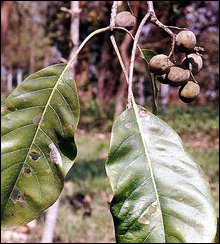
A bunch of leaves and dried fruits of Thaan'ri
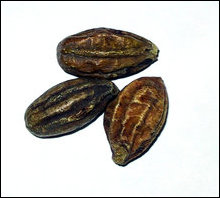
The seeds of Thaan'ri

Tha'ndikku'lam of Vavuniyaa district
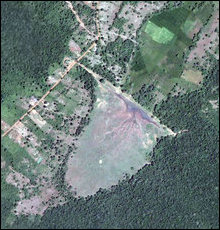
An example of a small ku'lam, showing the catchment area, tank, bund and the cultivation fields. Ilamaruthangku'lam in Vavuniyaa district. [Satellite image courtesy: Google Earth]
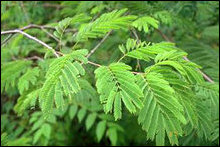
Uyilai/Usilai (Acacia pennata) [Photo courtesy: R.X. Pharma / Website]

Uyilai/Usilai (Acacia pennata) [Photo courtesy: Vietnam Flowers, www.pbase.com/hoanghai/]

Uyilai/Usilai (Albizia amara) [Photo courtesy: Sh@ist@'s photostream, flickr.com]

Uyilai/Usilai (Albizia amara) : Flower. [Photo courtesy: fleurs.cirad.fr]
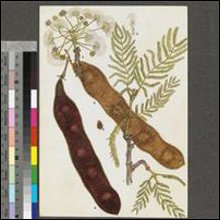
Uyilai/Usilai (Albizia amara): Pods, used as a substitue for soap nut. (Cheeyaakkaay) [Illustration courtesy: The Trees of Central Africa; p. 259, Royal Botanic Gardens, Kew]

Vaakai (Albizia lebbeck) : Flower and foliage. [Photo courtesy: Paul Latham, Photos of flowers and plants from Bas-Congo (D.R. Congo - Africa)]

Parasu/Puna-murukku (Butea frondosa or Butea monosperma): The tree, photographed at Kalmadu-nakar, Vanni, in September 2007. [Photo: TamilNet]

Parasu/Puna-murukku (Butea frondosa or Butea monosperma): The foliage, photographed at Kalmadu-nakar, Vanni. [Photo: TamilNet]

Parasu/Puna-murukku (Butea frondosa or Butea monosperma): Close-up of tripartite leaves, photographed at Kalmadu-nakar, Vanni. [Photo: TamilNet]

Parasu/Puna-murukku (Butea frondosa or Butea monosperma): close-up of flowers [Courtesy: www.tropicamente.it]
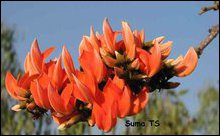
Flame of the forest: Another example from Bangalore. The whole tree is seen with such bunches, bereft of leaves, between January and March. [Courtesy: Wikipedia, Photo by Suma Tagadur]
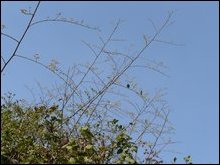
Thudari / Thodari / Thodali: Zizyyphus rugosa Lam [Photo courtesy: Dinesh Valke's Photostream, flickr.com, Creative Commons]

Thudari / Thodari / Thodali: Zizyyphus rugosa Lam, details. [Photo courtesy: Dinesh Valke's Photostream, flickr.com, Creative Commons]
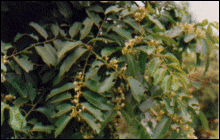
Kadalaagnchi (Olax scandens): Foliage [Photo courtesy: ku.ac.th]

Kadalaagnchi (Olax scandens): Fruit newly from the blossom. [Photo courtesy: Joseph Lai, 2003, eart-h.com]

Kadalaagnchi (Olax scandens): Bunch of ripe fruits. [Photo courtesy: ku.ac.th]
Previous columns:



























